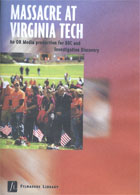
Massacre at Virginia Tech 2008
Distributed by Filmakers Library, 124 East 40th Street, New York, NY 10016; 202-808-4980
Produced by Jonathan Hacker
Directed by Jonathan Hacker
DVD, color, 52 min.
College - Adult
Crime, Psychology
Date Entered: 12/17/2009
Reviewed by Wendy Highby, University of Northern ColoradoMassacre at Virginia Tech is a journalistic treatment of the shootings at Virginia Polytechnic Institute & State University in Blacksburg, Virginia on April 16, 2007. It was originally broadcast as an episode of BBC’s This World, an international investigative documentary series. The piece conveys the tragic events through interviews with survivors, descriptive narrative, and campus footage. But chiefly, the work psychologically profiles the mass murderer, Seung-Hui Cho. The documentary strives to discover Cho’s state of mind and motivation through an investigation of his background and brief interviews with classmates, roommates, and a professor. Relatives in South Korea—a great aunt and grandfather—comment on the Cho family. Excerpts of Cho’s self-made video are included.
Behavioral experts inform the profile. Two experts who interviewed the immediate family following the massacre have the most didactic screen time. Forensic behavioral scientist and former FBI profiler Dr. Roger Depue provides insight into the self-loathing, anger, and destructive fantasies evident in Cho’s writings. Dr. Bela Sood, a child psychiatrist, explains Cho’s display of multiple personas and his family dynamics. Dr. James Griffith was a supervising psychiatrist at the Center for Multicultural Human Services where Cho was treated during his teen years. Griffith briefly comments upon Cho’s diagnosis of major depression and selective mutism and the prescribed counseling modality, art therapy. He describes Cho’s shyness, anxiety, communication problems, and fascination with the Columbine Massacre. Dr. Elisa Shipon-Blum explains the phenomenon of selective mutism. The film does not directly address the issues of prevention and institutional response, nor does it delve into the extensive findings of Governor Timothy M. Kaine’s Virginia Tech Review Panel Report. Instead, it provides an overview of the event and important insights into Cho’s background and psychological state. It gives a basic context and could serve as a starting point for an undergraduate-level study of campus violence and the psychology of perpetrators.